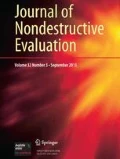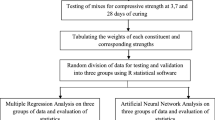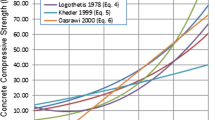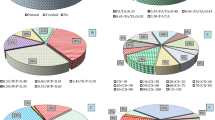Abstract
An artificial neural network (ANN) model and response surface methodology (RSM) were established to estimate the compressive strength of concrete by using the combination of three non-destructive tests (NDT); rebound number, pulse velocity tests and resistance surface. These techniques are utilized in an attempt to increase the reliability of the non-destructive tests in detecting the strength of concrete. These methods were trained using a set of different mixes and at different ages of concrete specimens. In this case, 180 experimental specimens were conducted and their data are published. Then, different neural network topologies and algorithms besides RSM were examined using the given data. The published models are for two combination including the combination of UPV and RN and the combination UPV, RN and SR. The results show that the accuracy of the published models are increased by aging. In addition, it is showed that RSM don’t need calibration process, while its accuracy is enough. Hence, RSM is a promising method to conduct on NDTs and compressive strength prediction, while ANN needs to perform many times to find the best accuracy.










Similar content being viewed by others
References
Beshr, H., Almusallam, A., Maslehuddin, M.: Effect of coarse aggregate quality on the mechanical properties of high strength concrete. Constr. Build. Mater. 17(2), 97–103 (2003)
Neville, A.M.: Properties of Concrete. Wiley, New York (2005)
Ali-Benyahia, K., Sbartaï, Z.-M., Breysse, D., Ghrici, M., Kenai, S.: Improvement of nondestructive assessment of on-site concrete strength: influence of the selection process of cores location on the assessment quality for single and combined NDT techniques. Constr. Build. Mater. 195, 613–622 (2019)
In Place Methods for Determination of Strength of Concrete; ACI Manual of Concrete Practice, Part 2: Construction Practices and Inspection Pavements, ACI 228.1R-989, Detroit, MI, 1994, p. 25.
Jones, R.: Testing of concrete by ultrasonic-pulse technique. In: Highway Research Board Proceedings (1953).
Kewalramani, M.A., Gupta, R.: Concrete compressive strength prediction using ultrasonic pulse velocity through artificial neural networks. Autom. Constr. 15(3), 374–379 (2006)
Ferreira, R.M., Jalali, S.: NDT measurements for the prediction of 28-day compressive strength. NDT E Int. 43(2), 55–61 (2010)
Poorarbabi, A.: Conversion factors between non-destructive tests of cubic and cylindrical concrete specimens. AUT J. Civil Eng. (2020). https://doi.org/10.22060/ajce.2020.17274.5624
Karahan, S., Büyüksaraç, A., Işık, E.: The relationship between concrete strengths obtained by destructive and non-destructive methods. Iran. J. Sci. Technol. Trans. Civil Eng. (2020). https://doi.org/10.1007/s40996-019-00334-3
Yucel, M., Namlı, E.: High performance concrete (HPC) compressive strength prediction with advanced machine learning methods: combinations of machine learning algorithms with bagging, rotation forest, and additive regression. In: Cioffi, R. (ed.) Artificial Intelligence and Machine Learning Applications in Civil, Mechanical, and Industrial Engineering, pp. 117–138. IGI Global, Pennsylvania (2020)
Chitti, A.N.: Assess Material Properties of Concrete Using Combined Ndt Methods (2019).
Qasrawi, H.Y.: Concrete strength by combined nondestructive methods. Simply and reliably predicted. Cem. Concr. Res. 30, 739–746 (2000)
Yilmaz, N.G., Goktan, R.: Comparison and combination of two NDT methods with implications for compressive strength evaluation of selected masonry and building stones. Bull. Eng. Geol. Env. 78(6), 4493–4503 (2019)
Sai, G.J., Singh, V.P.: Prediction of compressive strength using support vector regression. In: MENDEL, pp. 51–56 (2019)
Breysse, D.: Nondestructive evaluation of concrete strength: an historical review and a new perspective by combining NDT methods. Constr. Build. Mater. 33, 139–163 (2012)
Selvaraj, S., Sivaraman, S.: Prediction model for optimized self-compacting concrete with fly ash using response surface method based on fuzzy classification. Neural Comput. Appl. 31(5), 1365–1373 (2019)
Awolusi, T., Oke, O., Akinkurolere, O., Sojobi, A.: Application of response surface methodology: predicting and optimizing the properties of concrete containing steel fibre extracted from waste tires with limestone powder as filler. Case Stud. Constr. Mater. 10, e00212 (2019)
Busari, A., Dahunsi, B., Akinmusuru, J., Loto, T., Ajayi, S.: Response surface analysis of the compressive strength of self-compacting concrete incorporating metakaolin. Adv. Sci. Technol. Res. J. 13(2), 7–13 (2019)
Moodi, Y., Mousavi, S.R., Ghavidel, A., Sohrabi, M.R., Rashki, M.: Using response surface methodology and providing a modified model using whale algorithm for estimating the compressive strength of columns confined with FRP sheets. Constr. Build. Mater. 183, 163–170 (2018)
Hammoudi, A., Moussaceb, K., Belebchouche, C., Dahmoune, F.: Comparison of artificial neural network (ANN) and response surface methodology (RSM) prediction in compressive strength of recycled concrete aggregates. Constr. Build. Mater. 209, 425–436 (2019)
ASTM C 597-83 (Reapproved 1991).: Test for Pulse Velocity Through Concrete. ASTM, USA (1991)
BS 1881: Part 20 3.: Measurement of Velocity of Ultrasonic Pulses in Concrete. BSI, UK (1986)
ASTM C 805–85.: Test for Rebound Number of Hardened Concrete. ASTM, USA (1993)
BS 1881: Part 202, 1986.: Recommendations for Surface Hardness Tests by the Rebound Hammer. BSI, UK (1986)
El Mir, A., Nehme, S.G.: Porosity of self-compacting concrete. Procedia Eng. 123, 145–152 (2015)
ASTM C1202–12.: Standard Test Method for Electrical Indication of Concrete’s Ability to Resist Chloride Ion Penetration. ASTM International, West Conshohocken, PA, 8 pp (2012).
AASHTO T 277: Standard Test Method for Electrical Indication of Concrete’s Ability to Resist Chloride. American Association of State Highway and Transportation Officials, Washington, DC 12 pp. (2007)
No, T.C.S.: Guidebook on Non-destructive Testing of Concrete Structures. Int. Atomic Energy Agency, Vienna (2002)
Ramezanianpour, A.A., Pilvar, A., Mahdikhani, M., Moodi, F.: Practical evaluation of relationship between concrete resistivity, water penetration, rapid chloride penetration and compressive strength. Constr. Build. Mater. 25(5), 2472–2479 (2011)
Bezerra, M.A., Santelli, R.E., Oliveira, E.P., Villar, L.S., Escaleira, L.A.: Response surface methodology (RSM) as a tool for optimization in analytical chemistry. Talanta 76(5), 965–977 (2008)
Ghavidel, A., Mousavi, S.R., Rashki, M.: The effect of FEM mesh density on the failure probability analysis of structures. KSCE J. Civil Eng. 22(7), 2370–2383 (2018)
Babu, D.J., King, P., Kumar, Y.P.: Optimization of Cu(II) biosorption onto sea urchin test using response surface methodology and artificial neural networks. Int. J. Environ. Sci. Technol. 16(4), 1885–1896 (2019)
Myers, R., Montgomery, D., Anderson-cook, C.: Response Surface Methodology. Wiley, Hoboken (2009)
Demuth, H., Beale, M., Hagan, M.: Neural Network Toolbox. Mathworks, Natick (1994)
Author information
Authors and Affiliations
Corresponding author
Ethics declarations
Conflict of interest
The authors declare that there is no conflict of interest.
Additional information
Publisher's Note
Springer Nature remains neutral with regard to jurisdictional claims in published maps and institutional affiliations
Rights and permissions
About this article
Cite this article
Poorarbabi, A., Ghasemi, M. & Azhdary Moghaddam, M. Concrete Compressive Strength Prediction Using Neural Networks Based on Non-destructive Tests and a Self-calibrated Response Surface Methodology. J Nondestruct Eval 39, 78 (2020). https://doi.org/10.1007/s10921-020-00718-w
Received:
Accepted:
Published:
DOI: https://doi.org/10.1007/s10921-020-00718-w




